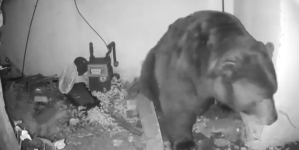-
Phyllis Lee Levin, Times Fashion Reporter and Biographer, Dies at 104 - 23 mins ago
-
Tears as 15-year-old cat in shelter over Thanksgiving, and now Christmas - 33 mins ago
-
San Diego woman who pleaded guilty to scheme to kill husband dies by suicide - 44 mins ago
-
DOJ Releases Another Batch of Epstein Files: Key Takeaways - about 1 hour ago
-
‘Lion King’ Child Star Imani Smith Killed At 26; Boyfriend Charged With First-Degree Murder - about 1 hour ago
-
L.A. wasn’t dreaming of a wet Christmas, but that’s what we got. And it can’t be returned - about 1 hour ago
-
Immigrant Nurse Is Among 2 Dead in Pennsylvania Nursing Home Explosions - 2 hours ago
-
Honduras Declares Nasry Asfura, Trump Ally, Winner of Presidential Election - 3 hours ago
-
Trump Tosses Lifelines to the Struggling Coal Industry - 3 hours ago
-
Dog Surrendered to Shelter Just Before Christmas—Reason Breaks Hearts - 3 hours ago
SoCal’s big storm: Evacuation warnings, road closures, tips for surviving
An atmospheric river storm should bring rain — heavy at times — to Southern California beginning Thursday night through the weekend.
Under the storm scenario deemed most likely by forecasters, downtown Los Angeles would see 2.62 inches of rain Friday morning through Sunday.
Key warnings
- Evacuation warnings are in effect from 6 p.m. Thursday through 11 a.m. Sunday in areas near recent burn scars, due to the risk of mud and debris flows. This includes areas near the Palisades, Eaton, Kenneth, Sunset and Hurst fires that burned in January’s firestorm.
- Topanga Canyon Boulevard between Pacific Coast Highway and Grand View Drive will close at 10 p.m. Thursday due to the high potential for heavy debris flows, according to the California Department of Transportation. The roadway is expected to remain closed through the Friday morning commute and potentially through the weekend.
Mudslide safety
- An intense rain (typically about half an inch per hour — like a thunderstorm) on a recently burned slope can trigger a debris flow.
- Just a few minutes of intense rain can start a debris flow. The National Weather Service will issue a flash flood watch or warning for your area when rainfall is anticipated to be intense. Note that it’s the rain in the mountains that will start the debris flow, even if it’s not raining — or only sprinkling — where you live.
- Debris flows can hit new areas or return to previous areas; they might be smaller — or larger — the next time. Whatever happened before, the next time could be different.
- Debris flows move fast! If you wait to see if a debris flow is coming your way, it will be too late to leave safely. You cannot outrun a debris flow.
- Find the highest point nearby (such as a second story room or the roof) and be ready to get there at a moment’s notice. Listen and watch for rushing water, mud, and unusual sounds. Survivors describe sounds of cracking, breaking, roaring, or a freight train in advance of a debris flow.
- Debris flows can start in places they’ve never been before. They can leave stream channels and plow through neighborhoods. When a debris flow is small, people can control it with walls, K-rails and sandbags. When a debris flow is big enough, nothing can stop it.
- Storms that can cause debris flows can also cause more common flooding dangers.
- Be aware that the soil may be waterlogged and that more rain can trigger debris flows.
- Debris flows can bury people sleeping in lower-floor bedrooms adjacent to hazardous slopes.
Driving in rain
1. Don’t enter flooded streets. As little as 6 inches of water can cause cars to stall or knock an adult off their feet. Two feet of water can sweep a car off the road, including an SUV or pickup truck. Any amount of water means you won’t be able to see what condition the road is in. Heed all road closure notifications and instructions from emergency responders.
2. Turn on your headlights. If your windshield wipers are on, your headlights should be too. It’s the law.
3. Drive slowly. Speed limits aren’t speed minimums. Leave extra time to get to your destination, and use extra caution.
4. Don’t tailgate: It takes longer for vehicles to stop on wet roads, so leave even more distance than usual between your car and the one ahead.
5. Check your tires. Make sure they’re properly inflated and not too bald to risk on wet streets.
6. Watch our video.
Source link










